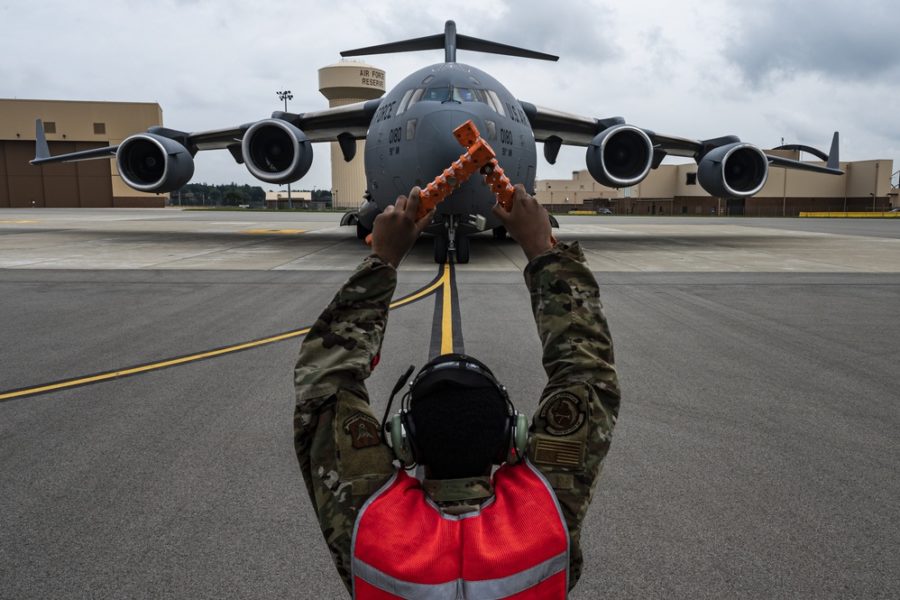In the wake of the massive Afghanistan airlift operation, Air Mobility Command is surging its use of C-5s in order to give its C-17 aircraft and crews a break, officials said Sept. 20 at AFA’s Air, Space & Cyber Conference.
Gen. Jacqueline D. Van Ovost, head of Air Mobility Command, detailed the shift in a roundtable with reporters discussing Operation Allies Refuge, which transported more than 124,000 people out of Hamid Karzai International Airport in Kabul from Aug. 14 to 30.
“It was one of the largest surges we’ve had. But we’ve surged before, and after you surge, there is a natural period where we want to make sure we tidy up the airplanes, to get them the services that they need, and get the crews the rest and the recovery, and frankly, the additional training on other missions that they weren’t focused on while they were solely focused on the NEOs and our top priority for the command,” Van Ovost said.
The Kabul airlift, which Van Ovost called the largest non-combatant evacuation operation airlift in U.S. history, pushed the Air Force’s fleet of C-17 Globemasters to levels far beyond their normal operational pace—roughly half of 222 C-17s in the entire Air Force were committed to the operation.
“On a given day, we have about 60 C-17s in the system operating globally,” said Brig. Gen. Daniel A. DeVoe, commander of the 618th Air Operations Center. “During this NEO, we would have 60 just in the [Central Command and European Command area of responsibility]. And at the height, we had an average of 113 per day.”
On Aug. 15, one of those C-17s ferried out 823 people, setting a new record for the most passengers transported in a single flight on a Globemaster III and making international headlines. On at least three other C-17 flights, babies were delivered.
There were also moments of tragedy, however. In one instance, desperate Afghans breached the airfield and attempted to climb onto a C-17 as it took off. The Air Force later announced it had discovered human remains in the wheel well of the aircraft and was launching an investigation.
On Sept. 20, Van Ovost said she could not comment on that specific incident as the investigation is still ongoing, but stressed the support provided to the crew on that flight.
“The most important thing for us was to take care of the crew and ensure that they had the support services necessary at Al Udeid (Air Base) to be able to process what happened, to get interviewed, and the most important thing for them was to get back into the fight,” Van Ovost said. “So after a period of time, we were able to place them back into the fight and continue to do NEO, and sort of process for them what has happened.”
Other crews were also eager to contribute as much as possible, DeVoe added.
“The aircraft commanders always have the opportunity to say, ‘Hey, the crew needs to rest. We need to be safe and step back from that.’ What we found was that they were motivated, dedicated, and would frankly come back to us with waivers and ask to go longer and to do more, and we would have to actually reel them back in,” DeVoe said.
In the aftermath, though, the Airmen who participated in the evacuation have needed to slow down and receive support, said Col. Colin McClaskey, 821st Contingency Response Group deputy commander.
“These are significant, traumatic events for those folks that are there. Lives are truly impacted, [and] unfortunately, in some cases, destroyed. Our Airmen, and all of our partners and allies that were there, they see that. It’s very personal for them,” McClaskey said.
McClaskey added that commanders at the 621st Contingency Response Wing have offered chaplains and mental health professionals as resources for Airmen when they arrived home.
While crews recover, planes will also need time. The evacuation itself had relatively few maintenance issues—“Frankly, I expected more aircraft to break than did,” DeVoe said—but longer-term work is still needed, hence the need for more C-5s.
“At the height, at any one given moment, we would have 23 C-17 teams in the air, somewhere around the globe in support of this effort, flowing through that system,” DeVoe said. “And so those crews, we are giving them a little bit of a break on the scheduling. We’re using some other airframes, so we’ve increased utilization of the C-5. We’ve surged its capacity so that we can now take the C-17 down just a little bit from normal averages and numbers, to give the maintainers at home station the chance to continue a little bit deeper maintenance on those aircraft.”
